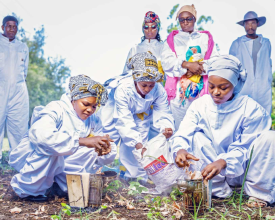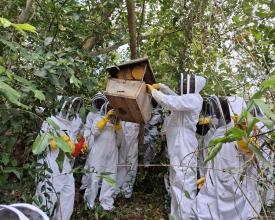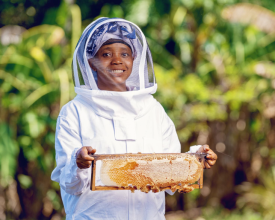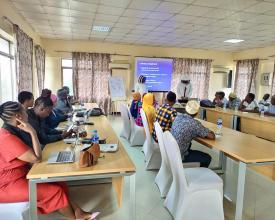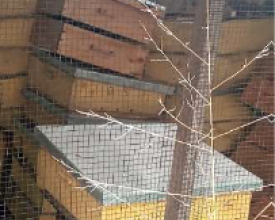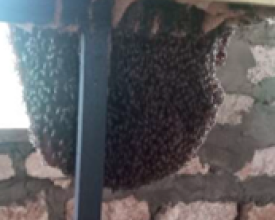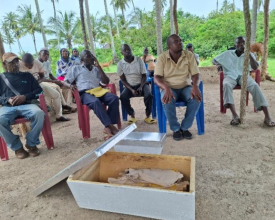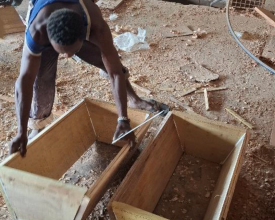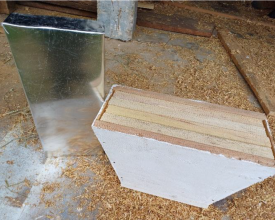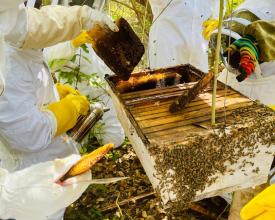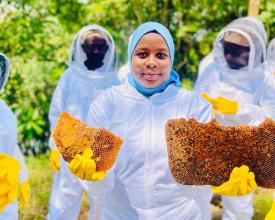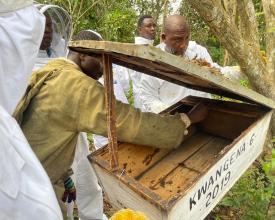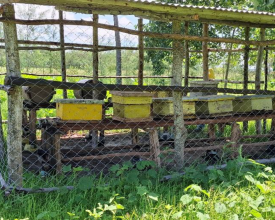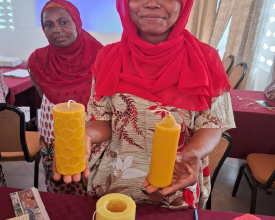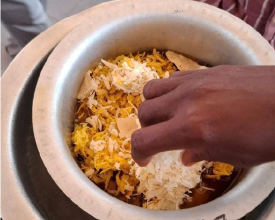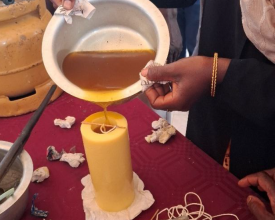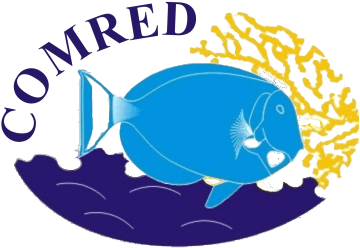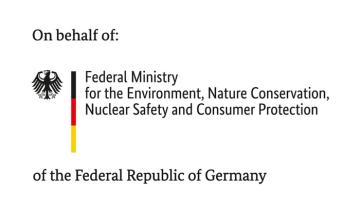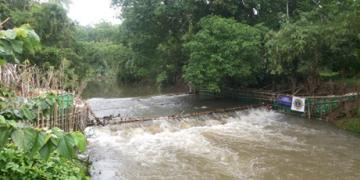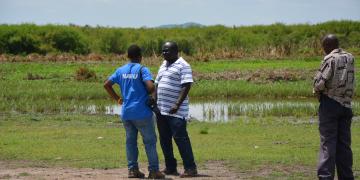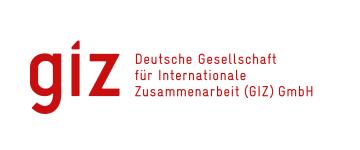
Gender-Inclusive Apiculture for Mangrove Protection and Livelihoods in Kwale and Tanga
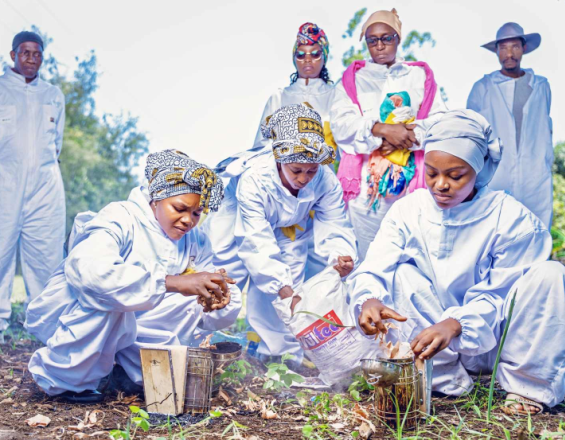
The IKI-BMUKN funded project Transboundary conservation and sustainable management of coastal and marine biodiversity in Kwale, Kenya and Tanga, Tanzania supports the conservation of marine and coastal biodiversity through community-based and gender-inclusive approaches. To reduce pressure on mangrove ecosystems, the project introduced sustainable apiculture as an alternative livelihood for local communities in Kwale and Tanga. The mentorship training takes place in two parts: The first part focuses on beehive construction, colony management and honey production. The second part is delivered when the honey is ready for harvest and builds skills in processing and value addition, including the use of beeswax for making products such as candles and ointments. Through mentoring and inclusive training design, women who were previously excluded due to cultural taboos have now become active participants in beekeeping. The project supports both environmental protection and local income generation.
Contexte
Challenges addressed
- Mangrove Habitat Degradation
Mangrove ecosystems in Kwale County (Kenya) and Mkinga District (Tanzania) face significant threats from unsustainable exploitation for wood and non-wood products, conversion to agriculture, aquaculture, and pollution. - Low Honey Production and Poor Quality
Production is low due to limited beekeeping skills, substandard hives and equipment, and poor harvesting techniques, resulting in poor honey quality. The honey value chains in Kwale and Mkinga lack structured market linkages and value-addition activities, limiting community income potential - Limited Technical Capacity
Local beekeepers, extension staff, and carpenters have inadequate skills and lacked training, significantly impacting hive occupancy and honey production. - Gender-based exclusion of women from beekeeping: For generations, beekeeping in Kenya’s coastal communities has been regarded as a male-dominated practice, deeply entrenched in traditional and religious norms. This denied women access to the economic & social benefits of honey prod.
Emplacement
Traiter
Summary of the process
The four building blocks are designed to function as an integrated process that supports sustainable, community-led apiculture. The initial value chain analysis (Building Block 1) provided the foundation by identifying knowledge gaps, equipment deficiencies, and opportunities for targeted intervention. This informed the development of the carpenter training (Building Block 2), which addressed the lack of quality beehives and enabled local production using improved designs. With high-quality hives available locally, the project implemented a first phase of capacity building (Building Block 3), equipping selected community members and government officers with practical and theoretical skills to manage hives effectively and share knowledge through a Training of Trainers model. Once honey production was underway, the second training phase (Building Block 4) introduced hands-on instruction in value addition and product development, empowering participants to process and market hive products using local materials. Together, the blocks form a stepwise approach from diagnostics to capacity building and product development, increasing both ecological and economic outcomes.
Building Blocks
Analysis of the Mangrove Honey Value Chain
The project conducted an in-depth value chain analysis of mangrove honey in Kwale (Kenya) and Mkinga (Tanzania) to guide strategic interventions supporting conservation and local livelihoods. Using the ValueLinks methodology, the assessment mapped actors and flows across the chain, including beekeepers, input suppliers, carpentry workshops, extension services, traders, and consumers. Key challenges identified included substandard hive equipment, low production, lack of training, and weak market linkages. Most honey is sold locally with minimal value addition. The analysis revealed potential to brand mangrove honey as a niche ecological product. Recommendations included training beekeepers and carpenters, promoting individual hive ownership, establishing honey collection centers, and strengthening market access. This analysis ensured that project interventions directly addressed field realities and laid the foundation for the capacity building and marketing work that followed.
Enabling factors
The presence of active technical partners such as WWF, WCS, IUCN, CORDIO and Mwambao created a strong support network beneficial for the analysis. Local carpenters and input suppliers in both Kwale and Tanga were already producing hives, creating a practical entry point. Beekeepers and government officers provided production data and candid insights during field visits and interviews, and the use of ValueLinks methodology helped structure the mapping process.
- Participation and input from key stakeholders, including beekeepers, government officers, and NGOs.
- Existing data and local knowledge from previous beekeeping initiatives.
- Clear methodology (standardized questionnaires, semi-structured interviews, field observations) ensuring consistent and verifiable data collection.
Lesson learned
Conducting a value chain analysis early in the project helped align interventions with real needs. Beekeepers’ challenges, such as poor hive quality, low production, and inadequate training, were addressable with targeted support. Group apiaries were often ineffective therefor promoting individual ownership improved outcomes. The demand for mangrove honey presents an opportunity for branding and income generation but requires investment in quality control and aggregation. Mapping the chain also revealed gaps in value addition and highlighted the importance of training and mentorship, especially through a Training of Trainers approach.
Carpenter Training for Improved Beehives
In both Kwale (Kenya) and Mkinga (Tanzania), locally produced beehives were often substandard and contributed to poor colony occupancy and low honey yields. The project responded by identifying carpentry workshops and training selected carpenters in the production of improved Kenya Top Bar Hives (KTBH) and other standardized models. In Kwale, two workshops (Lunga Lunga and Tiwi) were targeted, with Lunga Lunga already producing hives at scale but requiring technical improvement. In Mkinga, training took place in Tanga City. The training emphasized correct hive dimensions, appropriate materials, and basic bee biology to ensure the carpenters understood the functionality of each design feature. Following training, the workshops continued to produce hives to meet local demand, allowing community members to purchase hives rather than rely on donations. This helped build local ownership and supported a sustainable model for hive supply that could be scaled beyond the project. This intervention also laid the groundwork for additional support to beekeepers, who could now access better equipment within their region.
Enabling factors
Existing carpentry workshops in Kwale and Tanga had experience with hive production and were open to improving their skills. Local demand for hives was increasing as apiculture training was set to expand. The project had access to technical experts who could guide training, and input from beekeeping officers and experienced beekeepers ensured practical relevance. The training also benefited from a clear gap in the market: standard hives were unavailable or unaffordable before this intervention.
- Skilled local carpenters available within the community.
- Availability of suitable local materials for hive construction.
- Clear guidelines and standard specifications provided by trainers, directly linked to bee biology.
Lesson learned
Local carpenters were eager to participate and could absorb high-volume orders, but lacked understanding of key design features without dedicated training. Training content must go beyond woodworking and include bee biology to ensure hive functionality and ease of inspection. Substandard hive production leads to poor occupancy and reduced trust in apiculture as a livelihood. Continued quality control remains a challenge and should be addressed through follow-up support. The model works best when carpenters are embedded in local markets and directly interact with beekeepers. Training carpenters also shifts the local economy from donation-driven models to community-based entrepreneurship. A shared understanding between beekeepers, extension officers, and carpenters helps avoid misalignment between hive design and management practices. The success of this approach shows that supporting upstream actors in the value chain can improve outcomes for end users.
Training of Trainers in Sustainable Beekeeping Practices
Beekeepers in both Kwale and Mkinga had limited knowledge of improved hive management and struggled with low yields, poor equipment handling, and lack of confidence in basic apiculture practices. To address this gap, the project delivered a comprehensive Training of Trainers (ToT) programme on sustainable beekeeping practices. Participants included selected beekeepers, women and youth, as well as livestock production officers. The training focused on key topics such as bee biology and ecology, apiary site selection, colony management and multiplication, pest and disease control, pollination services, beekeeping equipment, record keeping, and the impact of pesticides on bees. Hive products and current research in the sector were also covered. Practical, hands-on learning was emphasized to ensure participants could apply knowledge immediately and confidently. The involvement of extension officers improved institutional capacity to support beekeepers beyond the project. Trained individuals were expected to pass on their knowledge and mentor others in their communities, contributing to broader uptake of improved practices and long-term sustainability of beekeeping as a nature-based livelihood in mangrove areas.
Enabling factors
- Active involvement and support from local government and community-based groups. The involvement of livestock officers increased institutional ownership, and the presence of abundant forage and water made technical improvements directly impactful.
- Availability of suitable apiaries for practical demonstrations. Hands-on training approach was key
- Use of accessible training materials and local language explanations to enhance comprehension.
Lesson learned
Without hands-on training, many groups struggled with basic hive management, harvesting techniques, and recognizing ripe honey. This led to low yields, colony absconding, and even spoilage of harvested honey. The ToT model allowed for local knowledge sharing, but follow-up mentoring is critical to reinforce learning and avoid skill gaps. Including government officers in the training proved beneficial, as it helped bridge the gap between producers and support services. In some cases, livestock officers lacked demonstration equipment and had not received prior training in hive management, limiting their ability to support communities. Trainings need to include practice with real hives, not just demonstrations. In future, ToTs should always receive refresher courses and facilitation to provide ongoing peer support in their communities.
Value Addition through creation of Bee-Based Products Using Locally Available Materials
The second phase of the apiculture training, conducted in Kwale, focused on post-harvest handling and value addition of hive products. It was designed as a follow-up Training of Trainers (ToT) activity to complement the technical skills acquired during the first phase. Participants included beekeeping ToTs and select group members who had harvested honey from their hives. The training covered proper harvesting techniques, hygiene, and methods for processing raw honey and hive by-products such as beeswax and propolis. Hands-on sessions enabled participants to make a range of marketable items including beeswax candles, body cream, lip balm, lotion bars, burn ointment, and cough syrup. Locally available materials such as coconut husks, bamboo, and recycled glass were used in packaging and product design. The training emphasized product quality, shelf life, and branding to improve marketability. This phase also encouraged innovation and peer exchange, as participants shared ideas for using bee products in traditional medicine or personal care. The value addition component strengthens income potential for beekeepers and supports the broader objective of creating sustainable, mangrove-compatible livelihoods.
Enabling factors
Participants had already gained practical experience from the first training phase and were motivated to expand their knowledge. Availability of harvested honey from earlier installed hives allowed for immediate hands-on practice. Trainers brought experience in product formulation and packaging using local materials. Support from local organizations and aggregation points created pathways for future sales. Community interest in natural products helped position value addition as a viable income stream.
Lesson learned
Many participants had no prior knowledge of processing hive products and appreciated the hands-on, practical approach. Demonstrating value-added product options boosted confidence and motivation, especially among women participants. Using familiar, locally sourced materials for packaging helped reduce costs and increased relevance for rural producers. Peer learning emphasized in the Training of Trainers approach proved effective, as some participants began mentoring others on value addition even before formal aggregation models were in place. Training participants only once is not sufficient; refresher sessions and continued support are essential to improve product quality and market readiness. Overall, linking production to value addition encouraged stronger hive ownership and long-term commitment to apiculture.
Impacts
Socio-economic:
- Increased colonization of existing hives as well as increased amount of new hives
- Honey yields have improved in several beekeeping groups. For example, Tunusuru Group increased from 14 kg of unripe and fermented honey to 25 kg of ripe honey from only 2 hives, achieving 12.5 kg per hive, which exceeds the average yield of 10 kg per hive
- 21 women have received training in hive management and value addition, contributing to household income and shifting community perceptions
- Seven different bee-based products are being produced locally, including beeswax candles, lip balm, and body cream
Beneficiaries
- Local beekeeping groups and community members in Kwale County, Kenya, and Mkinga District, Tanzania
- Women and youth who had limited access to income-generating opportunities
- Local carpenters in hive construction training
Global Biodiversity Framework (GBF)
Sustainable Development Goals
Story

The Hum of Change: Beekeeping and the Women of Yungi
The tide pulls back, revealing a narrow path through the glistening sand, the only way to reach Yungi by foot before the sea reclaims its passage. Here, on this quiet island off Kenya’s south coast, time seems to slow. As dawn breaks, Yungi stirs to life—not with the sounds of traffic or machines, but with nature’s melody. Birds call from the ancient Kaya forest, their songs mingling with the steady hum of bees weaving through the dense thickets, collecting nectar from wild blossoms. This is where the land speaks, and those who have lived here long enough have learned to listen.
At the only water point in Yungi, we find Khadijah and her female friends fetching water for the upcoming apiary. She has watched this land change, watched its people shift like the tides. Her children grew up here, their small feet treading the same narrow paths to school past the mangrove stand in Majoreni.
Her father introduced her to beekeeping as a child. She remembers how he would disappear into the mangroves and the nearby forest to check on his 4 log hives, returning home with golden honey that he carefully stored, waiting for a buyer who might take weeks, even months, to come. The island’s isolation made everything slow: money, trade, and progress. But after he was gone, Khadijah did not let the hives go silent.She continued his work, growing from his old hives to six by adding two of her own, then received five Langstroth hives from COMRED.
At every harvest, she would fill her 20-liter jerricans with honey, waiting patiently for a buyer. For years, she sold her honey for as little as 250 KSh per kilogram, never knowing its true value. She farmed alongside beekeeping to sustain her family, knowing she had no other choice as the eldest daughter. Beekeeping was a legacy, but survival was a duty. It wasn’t until she attended an apiculture training that she learned the truth: her honey, processed correctly, could sell for up to 1,000 KSh per kilogram. The realization struck her like a wave against the shore. Honey wasn’t just a tradition; it was a lifeline, a bridge to something greater.
And now she is building that bridge. It is a phrase borrowed from her training, but in her world, it means more. It is about crossing over challenges, leading her people, and making sure no one is left behind. As a matriarch, she walks ahead, and the others follow.
The women of Yungi will stop at nothing until their hives are full and their community thrives!
(Source: COMRED)

